NVIDIA’s GeForce GTS 450: Pushing Fermi In To The Mainstream
by Ryan Smith on September 13, 2010 12:02 AM EST- Posted in
- NVIDIA
- Fermi
- GeForce GTS 450
- GF106
- GPUs
Power, Temperature, & Noise
As we’ve discussed in previous articles, with the Fermi family GPUs no longer are binned for operation at a single voltage, rather they’re assigned whatever level of voltage is required for them to operate at the desired clockspeeds. As a result any two otherwise identical cards can have a different core voltage, which muddies the situation some. All of our GTS460 cards have an idle voltage of 0.962v, while their load voltage is listed below.
| GeForce GTS 450 Load Voltage | |||||||
| Ref #1 | Ref #2 | Asus | EVGA | Palit | Sparkle | ||
| 1.05v | 1.062v | 1.125v | 1.112v | 1.087v | 1.087v | ||
As all of our vendor cards are factory overclocked, it skews the average voltage high. Among our two reference cards we see load voltages of 1.05v and 1.062v, while the overclocked cards are between 1.087v and 1.125v. As NVIDIA is making every effort to promote the overclocking capabilities of the GTS 450, this should give us a good baseline of where we want to be for the best overclocks.
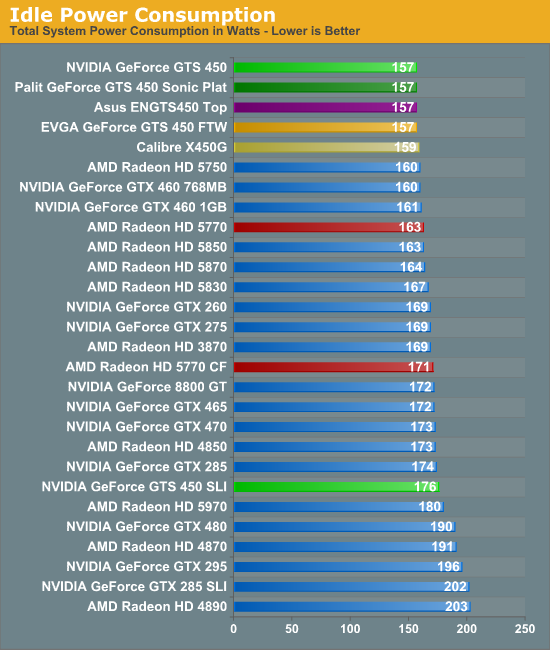
NVIDIA does not provide an official idle TDP, however it’s very clear that it must be very low. All of our GTS 450 cards bring in the lowest idle power consumption levels on this chart. We know the 5750 is rated for 16W at idle, so it’s safe to assume that the GTS 450 can beat that. Given the extremely low idle clocks of the GTS 450 (50MHz core, 270MHz memory) there’s a good chance this is the reason for the impressive idle power consumption.
We haven’t talked about SLI/CF much, but it bears mentioning here. NVIDIA doesn’t have an equivalent of AMD’s Ultra Low Power State for slave cards, which is why the GTS 450 can beat the 5770 as a single card, but lose in SLI/CF.
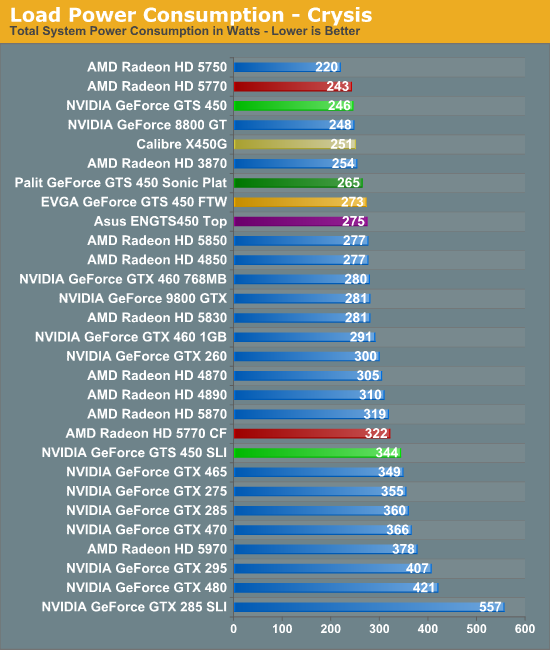

Under load the GTS 450 allows for some very low system power consumption numbers, however it can’t best the 5770. GF106 is a bigger die with more transistors so it’s not surprising that NVIDIA ends up drawing a bit more power here. But their performance also isn’t usually on par with the 5770, so they aren’t in a position to match AMD’s solid performance-per-watt. The overclocked cards do worse here of course, the worst of which is approaching 5850 power levels (and a testament to the 5850’s capabilities).
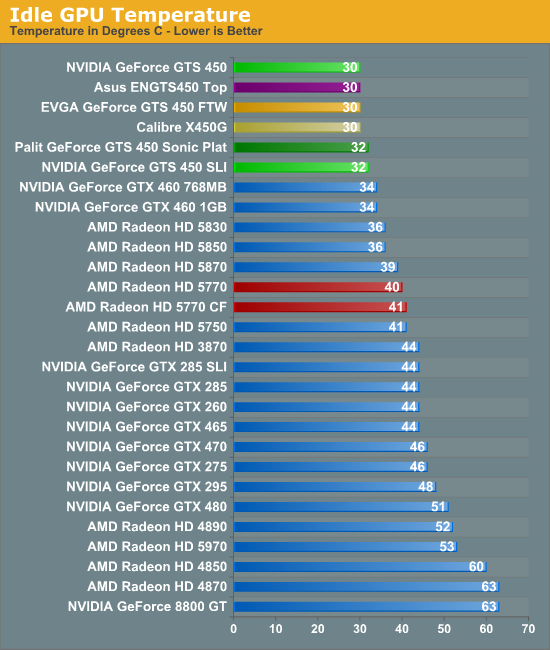
Along with giving us some of the lowest idle power numbers we’ve seen for a mainstream card, the GTS 450 also gives us the coolest temperatures. Even the GTX 460 can’t compete with the GTS 450, whose GPU barely breaks room temperature with the reference card. It’s also one of the few things the Radeon 5700 series is decidedly worse at, with the coolest of those cards getting up to 40C.
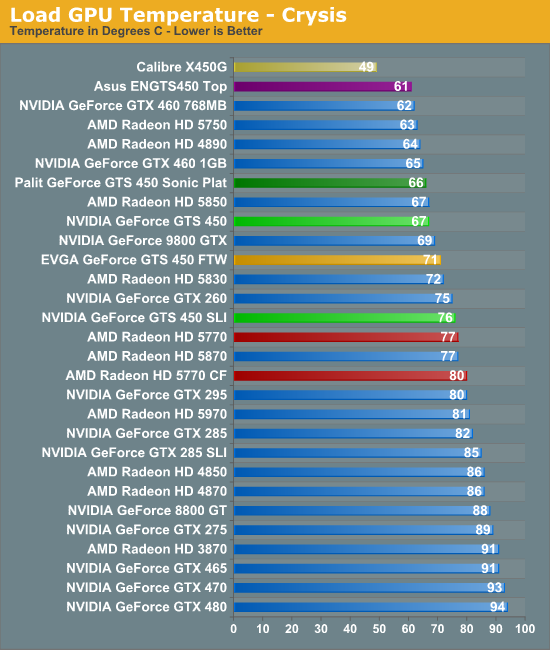

We’ll get to the Calibre card in our companion article focusing on the vendor cards, but for now we’ll stick to the reference and reference-like cards. The GTS 450 represents NVIDIA’s continued use of aggressive cooling. With a smaller all-aluminum heatsink it can’t hope to match the GTX 460, but at the same time it’s a good 10C ahead of the 5770 when it comes to Crysis. Even under Furmark the factory overclocked cards still only reach 5770 temperatures, showcasing just how good the cooling on these cards is.
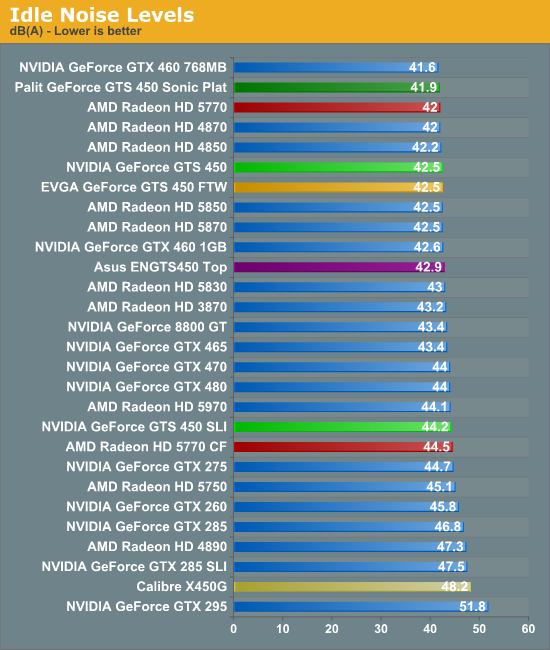
As always, the amount of noise generated at idle for a good card should be indistinguishable from other cards. The GTS 450 is no exception, generating around 42 dB(A) as we’ve come to expect.

Traditional wisdom for a video card is that if you have (relatively) high power draw you can either have a cool card or a quiet card but not both. The GTS 450 breaks the idiom wide-open – we’ve already established it draws more power than the 5770, and yet our reference card barely breaks the noise floor. At 43.3dB(A) it’s effectively silent, a feat not even the GTX 460 or the 5770 can claim. If you can ventilate your case at similarly quiet levels (necessary by fact that the GTS 450 exhausts some hot air in to the case) then we’re certainly looking at a contender for one of the most balanced HTPC cards ever.
Quickly, SLI is a bit of a different story. The reference design is great for a single card, but having two of such cards right next to each other truly suffocates the first card. We’ve said it once and we’ll say it again: if you can separate your Fermi cards, it’s in your best interest to do so.










66 Comments
View All Comments
lecaf - Monday, September 13, 2010 - link
Oh my wrong I missed the SLI partsorry
:)
mino - Monday, September 13, 2010 - link
That "SLI" detail ... :)jabber - Monday, September 13, 2010 - link
Buy a 5770 and OC it to 900/1300 like most should out of the box.Sorted.
Quidam67 - Saturday, September 18, 2010 - link
Agreed. The article repeatedly pointed out that an overclocked 450 catches up to a 5770, but never mentions that the 5770 generally overclocks very well so is likely to take back the lead anyway.Zokudu - Monday, September 13, 2010 - link
But it goes without saying that modern video drivers from both AMD and NVIDIA ridiculously huge, and this new installer doesn’t do anything to change that.I think your missing an are there. Otherwise wonderful article guys.
Lonyo - Monday, September 13, 2010 - link
Well, that whole bit isn't entirely accurate anyway. The NV drivers are more than 2x the size of AMD drivers, and AMD drivers aren't that much bigger than the drivers for more "mundane" things like ever printers and sound cards.Either way it's not entirely relevant at all.
iwodo - Monday, September 13, 2010 - link
Well Nv Drivers includes a lot more then ATI, otherwise they are about the same.But would Anandtech go on to find out just why Drivers Size is so huge. I have the feeling if the drivers were specifically written for one generation of graphics card it would save huge amount of space.
Taft12 - Monday, September 13, 2010 - link
I agree that there is probably a ton of code in there to support cards all the way back to 6xxx but also that this would lead to a support nightmare for users that don't know what model is in their PC.Too bad, but it's the nature of the industry and graphics tech is the fastest moving of them all.
Ryan Smith - Monday, September 13, 2010 - link
Actually we did something a bit like that early last year for the NV drivers.http://www.anandtech.com/show/3510
At the time the PhysX package was around 40% of the required space.
On modern drivers the languages have a lot to do with it. The NV International drivers are a good 30MB bigger than the English-only drivers.
heflys - Monday, September 13, 2010 - link
This card is such a disappointment. It performs worse than the year old card 5770, and only surpasses it when overclocked; it's also about the same price. Furthermore, in some reviews, the 5770 even beats it in Crossfire vs SLI comparison! To add further insult to injury, AMD is about to launch new cards shortly!This card has to be priced at $110-120 to be competitive in my book.